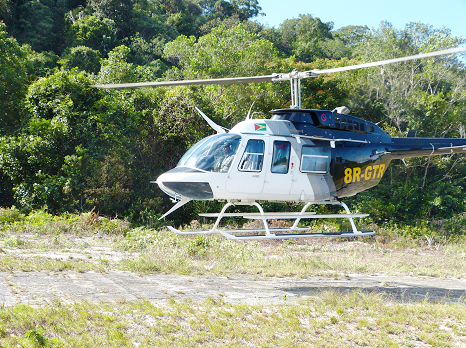The potential for commercial helicopter services in Guyana is a goldmine of opportunity, says Air Services Limited (ASL) General Manager Annette Arjoon-Martins, who also declared that since ASL commenced operations last year it has only scratched the surface of this but highly demanded service.

In November last year ASL became the first privately-owned company, licensed by the Guyana Civil Aviation Authority (GCAA), to offer commercial helicopter services. Though ASL only has one helicopter, Arjoon-Martins said, the last two months of business have been very good and a second helicopter is definitely a possibility.
The only other body licensed to carry out commercial helicopter services is the Guyana Defence Force (GDF), which was granted Cabinet Approval over 50 years ago to carry out such operations. The GDF has come under criticism on several occasions by many who claim that it was illegally offering commercial helicopter services. However, Director General of GCAA, Zulfikar Mohamed, said that the Defence Board has for the last few decades had the authority’s permission to fly commercially if it so desired.
During a sit down with Stabroek News, Arjoon-Martins said that the proliferation of helicopter services in Guyana has, and will continue to revolutionise the air service industry, and provide a wide array of advantages that were unattainable with the use of fixed wing aircraft, the traditional mode of commercial flights.
Arjoon-Martins said that with the expansion of the gold, petroleum and forestry industries, the use of helicopters will provide strategic advantages in terms of transport of goods, equipment and human resources directly to and from the base of operations. She said that this will save not only money, but time that would have been spend travelling on the rivers or driving along the unkempt roads.
She also said that the potential of helicopters for search and rescue and medevac purposes is unmatched, relative to its fixed wing counterparts.
“Our locally-owned and operated helicopter service can be readily utilised to enhance the search-and-rescue capacity of both the Guyana Defence Force and the Guyana Civil Aviation Authority in the often difficult aspects of such vital work. With a helicopter at the ready, we can now provide medical evacuation support directly from the remote interior locations to Ogle Airport where the nearest hospital is minutes away. It is no guess to say that lives will be saved in the process.”
Arjoon-Martins noted that helipads can be set up at a fraction of the cost and time needed for airstrips, are easily constructed and can be set up practically on any terrain. This is a significant advantage, and one that will pave the way for the increased use of the helicopter as opposed to fixed wing aircraft in these operations.
She also said that the helicopter’s hovering capability would be ideal for Monitoring and Evaluation (M&E) assignments as will be needed in the much touted Low Carbon Development Strategy (LCDS).
Arjoon-Martins said ASL possesses the requisite pilot and engineering capacity to maintain this service, having sent persons to the internationally renowned Bell Helicopter facility to receive the necessary training.
She said that the Guyanese public and several domestic and international private entities have expressed a decent amount interest in utilising the helicopter services for tourism as well as for the filming of documentaries.
ASL currently charges US$1,700 an hour for the helicopter service. According to Arjoon-Martins the machine comfortably seats seven passengers including the pilot and has an executive configuration which allows its passengers to fly in comfort. She added that the configuration can be easily changed to facilitate the transportation of cargo, or to hold 2 stretchers for medevac purposes.
Air Services Guyana has been operating in Guyana for more than half a century and has gone from having just one plane to a fleet of 22 fixed wing aircraft and one helicopter.




